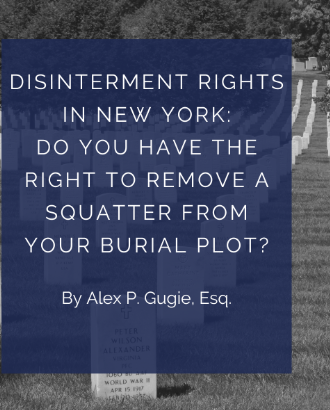Disinterment Rights in New York: Do You Have the Right to Remove a Squatter from Your Burial Plot?
Most people have heard about evicting an unwanted squatter from a piece of property. But what about evicting someone who is wrongly occupying your cemetery burial plot?
Under New York law, purchasers of cemetery burial space may have the right to remove others who have been improperly buried in their plots. Disinterring the remains of deceased person is not a simple process, however, and courts in New York State have not given any clear direction about when such a drastic step is warranted.
Under Not-for-Profit Corporation Law § 1510(e), a cemetery corporation has the authority to remove a body from the ground when the corporation, the owner of the burial plot, and the survivors of the buried person all consent to the removal. In addition, the law states that if any one of these parties objects, the party seeking disinterment can request an order from the county court of the county, or by the supreme court in the judicial district, where the cemetery is located overriding the objection.[1]
But how exactly does a court, faced with a request to disinter the remains of a buried person, decide whether the disinterment of a deceased person is required? Nearly a century ago, the Court of Appeals provided a succinct statement of the general principle underlying disinterment: “The dead are to rest where they have been laid unless reason of substance is brought forward for disturbing their repose.”[2] Some twenty years later, the Court of Appeals then provided some additional guidance, holding that “[g]ood and substantial reasons must be shown before disinterment is to be sanctioned.”[3] And other courts have stated that the wishes of the decedent him or herself are to be accorded the most weight in deciding whether to order disinterment.[4]
All of these standards that have been articulated over the years are vague—to say the least—and courts generally review requests for disinterment on a highly case-specific basis.
In one case, a desire to ascertain the cause of death of a decedent after he had been buried was not considered a good and substantial reason to remove him from his resting place.[5] However, a different court found that there was good and substantial reason to remove and relocate a decedent where a petitioner sought disinterment of her husband's remains on the grounds that he was not buried in a Catholic cemetery—and that, therefore, she and their children would not be able to be buried with him.[6] Perhaps more unexpectedly, a court ordered disinterment when it was presented with evidence that a decedent’s last wish was to be buried with special prayer beads, but he had in fact been buried without them.[7]
The purchase of a cemetery burial plot confers a property right that the law protects the owner of the plot from invasion by others.[8] Unless the deed states otherwise, however, a purchaser of a burial plot does not acquire complete fee simple ownership rights in the burial space. Rather, most courts would hold that a purchaser only acquires an easement right for burial purposes—which includes the right to set tombstones and monuments in memory of the deceased.[9]
Nevertheless, it seems likely that a court faced with a petition to disinter the remains of a deceased on the grounds that someone else has title to the burial plot would grant in favor of the petitioner. While no courts in New York have addressed this exact question, the fact that a purchaser of a burial plot acquires a definite property right almost certainly counts as “good and substantial reason” for removal of a deceased who does not have such a right. And because the cemetery—that allowed the improper burial in the first instance—is a necessary party to the proceeding, it may be that as part of the relief granted a court could order that the cemetery provide some other appropriate resting place for the body that is being disinterred.
Even in matters of life and death, it is fair to say that the law still protects the one with a deed over a squatter.
[1] N.Y. Not-for-Profit Corp. Law § 1510(e)
[2] Yome v. Gorman, 242 N.Y. 395, 403 (1926) (emphasis added).
[3] Currier v. Woodlawn Cemetery, 300 N.Y. 162, 164 (1949) (emphasis added).
[4] See, e.g., In re Herskovits, 48 N.Y.S.2d 906, 907 (Sup. Ct. 1944) (“It is settled that the wishes of a decedent in respect to the disposition of his remains are paramount.”)
[5] See Matter of Band, 117 A.D.2d 597 (1986).
[6] See In re Kelly, 16 A.D.3d 587, 792 N.Y.S.2d 133 (2005).
[7] See Application of Peruso, 58 Misc. 2d 915 (Sup. Ct. 1969).
[8] See City of New York v. Washington Cemetery, 17 Misc. 2d 847 (Sup. Ct. 1959).
[9] See Oatka Cemetery Ass'n v. Cazeau, 242 A.D. 415, 417 (App. Div. 1934)
